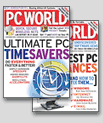
Microsoft Looks in the Crystal Ball
Research chief demonstrates Magic Paper, virtual classrooms, and other projects.
Yardena Arar, PCWorld.com
Wednesday, October 29, 2003
LOS ANGELES -- Tablet applications that quickly transform
math formulas into graphics, and classrooms where professors can field instant-message
queries from remote students: Both are leaping from the drawing board to
reality in Microsoft Research projects.
And both were demonstrated for a crowd of developers
at a keynote here Wednesday at the Microsoft Professional Developers Conference.
Rick Rashid, Microsoft Research senior vice president, described these projects
and others.
Rashid, whose talk was titled "Are We Done Yet?" rejects some pundits' view that the heyday of computing advances is past.
"We're really at the beginning," he said. "We've barely scratched the surface of what can be done yet."
Microsoft Research
employs more than 700 researchers, most of them working in Microsoft headquarters
in Redmond, Washington, but others located in California, Beijing, and Cambridge,
Massachusetts.
Focus on Graphics
Rashid said researchers are focusing on several areas, including greater exploitation of graphics processors.
"They're not just stunt boxes any more," he said,
echoing a theme expressed earlier in presentations about the next version
of Windows, code-named Longhorn. Longhorn
features a sophisticated visual display technology, called Avalon, that will
make greater use of graphics processors than do current versions of Windows.
Rashid said future graphics processors will handle
tasks that typically fall to the CPU, such as font rendering. He demonstrated
an application in which a graphics processor read data from a two-dimensional
image and transformed it into a detailed, three-dimensional image.
In another demonstration, sophisticated rendering
of water made the ocean in a gamelike scene of a figure standing on a beach
look much more realistic. The wavelets reflected sunlight, and the reflection
of the figure changed in intensity depending on the viewer's angle.
Another demo showed how the Sloan Digital Sky Survey
uses database and Web service technology to help map and catalog the northern
third of the detectable universe.
Rashid said Microsoft Research has done groundwork for the company's Smart Personal Objects (SPOT) initiative, in which objects such as wristwatches can receive news and alerts over a wide-area wireless network.
Glimpse of Future
Microsoft Research is also involved in "changing the
learning experience," Rashid said. He showed a video of a math lecture as
it might be given today and then as it might occur in the future. In the
forecast, a teaching assistant filtered student queries submitted by instant
message, and a remote student viewed a video of the lecture in the middle
of the night.
In a final set of demonstrations, Microsoft technology
evangelist John San Giovanni showed a pair of Tablet PC apps. Math Pad, developed
at Brown University, creates graphics--including the movement of a pendulum
and the path of a baseball hit by a bat--from handwritten drawings and equations
in real time. Magic Paper, from the Massachusetts Institute of Technology,
animates selected hand-drawn objects as they interact with stationary objects.
The program identifies both the stationary objects and the moving objects
by a stroke of the stylus.
"Microsoft Research believes that the student notebook
of tomorrow is really this highly sophisticated, digital mobile device,"
San Giovanni said.
|



